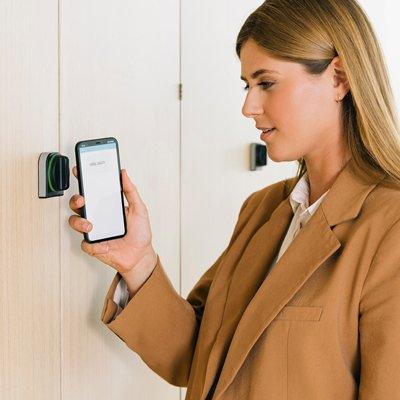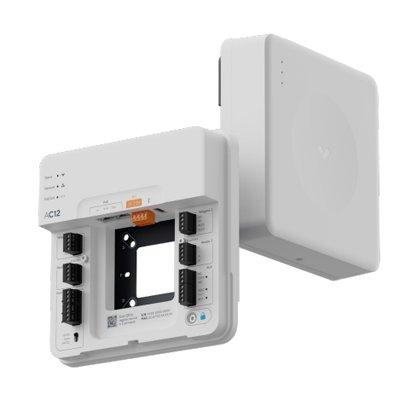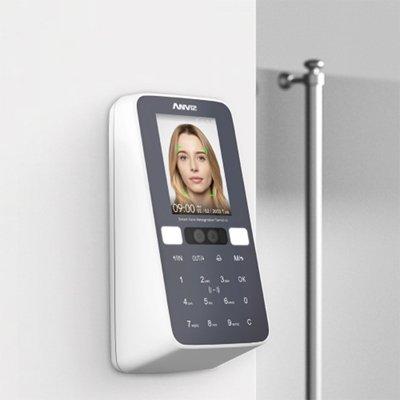 |
| More attention needs to be placed on the development of readers that can accommodate Wireless and Wi-Fi technology |
Many of the changes in the access control market are happening at the “edge” – at the reader level. Access control advances that continue to become more widespread include wireless and PoE-enabled access control hardware such as wireless locks and PoE door controllers, which both reduce installation costs. Other trends are related to mobility; one is the increased use of smart phones and tablets for day-to-day access control operations. Another is the increased adoption of mobile credentials – leveraging near field communications (NFC) or Bluetooth Low Energy (LE)-enabled technologies that allow smart phones to be used as access control credentials to enter a building instead of traditional credentials such as cards.
Emerging technology platforms can fragment and hinder the market, among both integrators and end users. Do we install and use Bluetooth, NFC or the latest in biometrics? Are they safe, proven, and are there standards? “Only time will prove which technologies are better,” says Greg Hetrick, PCSC’s director of marketing. “Until then, it’s anyone’s guess, often at the expense of real-world scenarios. By the time it’s proven, new technologies become available. The cycle is always turning.” The best approach is to find the right balance between today’s and tomorrow’s technologies, he adds.
Wireless and Wi-Fi technology is inching into the access control space, and because of this, more attention needs to be placed on the development of readers that can accommodate this technology. Accompanying issues include the level of integration with traditional physical access control systems and safety concerns when recommending and deploying these devices, says Robert Laughlin, president of Galaxy Control Systems.
John L. Moss, CEO of S2 Security, sees access control evolving in the next five years in relation to “bring your own device (BYOD),” global distributed systems in the cloud, and inexpensive wireless locksets. “With the ubiquity of smart phones and BYOD, people will use mobile devices as personal credentials, either with Bluetooth LE or by using an app built into the device,” he says.
“New business models will evolve around these new technologies that will benefit end users through reduced total cost of ownership and integrators through a shorter replacement cycle, which is typically long in access control,” Moss comments.
 |
| Hetrick believes that in the near future, smart phones or wearables will become the primary source for card access, door entry, system access, payments, health information and identification |
In the near future, access credentials will become more mobile and more portable, whether physical or cloud-based. “Your smart phone or wearable (smart watch) will become your primary source for card access, for door entry, system access, payments, health information and identification,” Hetrick says. Virtual credentials may live in the cloud versus on a device. If someone switches to a new employer, for example, no new credentials will be assigned. Rather, they are simply authorized and activated by the new employer and deactivated by the previous one. When it’s time to upgrade a device, the credentials are available via the cloud to the new device, Hetrick says.
“Device security will improve via biometrics (fingerprint, i.e., Touch ID; and perhaps facial recognition using a device’s camera) with multiple forms of authentication and rolling encryption,” Hetrick says.
“As a manufacturer, we hear about biometrics, NFC, these are all things we see, but it’s hard to integrate them into our platform,” says John Smith, senior channel marketing manager, Honeywell Security. “There are 100 different biometrics, not operating to a standard. Most of our systems can work with these things, most have a Wiegand or standard output, but the enrollment piece might be a problem and require a separate application. We as a manufacturer are watching it closely, but we haven’t seen it as a big draw.” For example, a predominant leader hasn’t emerged relative to NFC. Also, biometric readers are three to 10 times more expensive than a card reader, so cost justification has to come down, he adds.
Jason Ouellette, product line director, access control, Tyco Security, suggests the future of access control will be a matter of “back to the future.” He expects more access control systems will be based on a cloud environment, reminiscent of the days of mainframe computers. The edge devices that provide the monitoring, reporting and day-to-day management of access control will be comparable to yesterday’s “dumb” terminals. “Additionally, we will see a shift from the traditional plastic cards and fobs to electronic credentials managed through smart devices like mobile phones and tablets,” he adds.
“One more shift will be the use of biometrics, such as facial recognition, for access control, which will create a ‘frictionless’ mode of access control as the technology improves,” Ouellette says. “While the technology of cloud-based servers over mainframes and tablets or mobile phones provides far greater capabilities, it will also drastically change the way access control is installed, managed and encountered by end users over the next five years.”
More access control systems will be based on a cloud environment, reminiscent of the days of mainframe computers. The edge devices that provide the monitoring, reporting and day-to-day management of access control will be comparable to yesterday’s “dumb” terminals |
Richard Goldsobel, vice president, Continental Access, sees some movement to more secure (than Wiegand) RS-485 readers. However, he says the the hype for access control right now revolves around moving the access credential to smart phones, using either NFC or Bluetooth LE technology to communicate with the reader. Problem is, the technologies are battling, and both have their pros and cons, but the functionality will be similar. The convenience of the credential on the phone, of course, is the major driving factor, but the functionality also raises some new security concerns. Security may dictate that additional functions be running on the smart phone app, such as biometrics or PIN processing. However, a need for additional actions to be performed on the phone will reduce convenience, says Goldsobel.
“Your smart device will continue to play a larger role in the systems,” agrees Greg Love, vice president of sales, AMAG. “You can manage the system and get into the area, all with the same device.” He also sees additional options ahead for hosted, Web or embedded solutions – all from one manufacturer. “The customer can make the choice of how they would like to manage their security,” he says. New solutions will extend above and beyond access control and video management – including risk management, emergency preparedness and enhanced reporting outside of security responsibility. “It’s more of a total facility management system that takes advantage of the network in its entirety,” says Love.
New technologies also bring new risks. Hetrick says the market should consider carefully issues related to credential and identity security, whether lost, stolen, duplicated or authenticated. “Can an access point identify that the access device authenticates the actual physical identify of the user?” he asks. “Is a lost card or hacked and stolen mobile device with NFC access able to open a secure door? Or is the access point also smart, i.e., able to use facial recognition to confirm that the card or device and the user are indeed one and the same, and therefore authorized? Or is this just a duplicate access device or card being used by a criminal? Can a duress situation be discreetly announced and identified, perhaps granting access while simultaneously notifying authorities? Will virtual and cloud-based credentials be at risk for attack, theft or duplication? Technology opens new layers of security risks. Are these risks masked, unforeseen? What preventions can be enabled?”
Smith of Honeywell says the traditionally slow-moving access control market is being forced to embrace new and changing technologies, and many dealers are not comfortable with the situation. It takes a lot for a dealer to change its products or business model. Some are resistant to change, and others have a hard time finding qualified talent to deal with new technologies. “We are lagging behind technology as a whole,” says Smith. “A lot of dealers we have are resistant, it doesn’t fit their current business model, and they will have to change.”














































